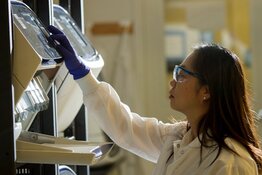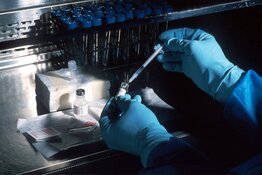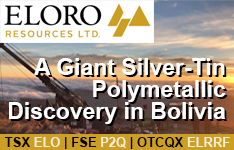The Life Sciences Report: Chen, we know you as a natural resource investor. How long have you been a life sciences investor? Is this a new category for you?
Chen Lin: I have been investing in life sciences on and off during the past decade, but my emphasis is on resources, where I'm still mostly focused. I started to look into life sciences again this year.
TLSR: Why?
CL: Resource stocks have a tendency to move together. They move up with quantitative easing by the European Central Bank (ECB) or the Federal Reserve, but when hope is diminished, they go down. The resource market has been moving in this way for the past few years, and that has driven me crazy. Fortunately, some of my stocks actually moved against the trend—Mart Resources Inc. (MMT:TSX.V) is a good example—and I am very proud of that. Still, those movers were very limited. I wanted to find ideas that were independent of the ECB or the Fed, risk-on, risk-off sentiment and the market direction—that would move more on their fundamentals. Biotech is a good sector in that way. I also looked at technology, but technology has the risk-on, risk-off problem. In addition, my portfolio has grown very rapidly, so I wanted to diversify.
TLSR: So the issue here is diversification. What important differences do you find between natural resources and life sciences or, more narrowly, biotech?
CL: They are very different. Natural resource companies are looking for the same thing in different places. Gold companies are looking for gold. Oil companies are looking for oil. Life sciences companies are looking for new approaches or compounds that can cure disease. They are looking for a magic bullet, a drug. It's very different.
"I only pick stocks that I understand. If I can understand it, many individual investors will be able to understand it as well."
However, like some junior resource companies, biotechs burn through money as they prove a new potential drug. The two sectors are similar in that an investor can look at a balance sheet to see how much cash a company has and how fast it is burning through that cash. On the other hand, the biotech cycle is highly dependent on U.S. Food and Drug Administration (FDA) approval. This kind of oversight does not exist in the natural resource sector.
TLSR: We know you primarily as a natural resource investor, but clearly your objective is growth, and you have done quite well. How do you approach a biotech stock?
CL: I am a bottom-up investor, and I invest in things that I can understand. I have explored a few different ideas in biotech recently, but I only picked two or three because I can understand them. I believe these have a very good chance of dramatic growth.
TLSR: Along that line, you have written recently that biotech is high risk and high reward. Can you make bigger gains with biotech than you can with junior mining stocks or junior energy stocks?
CL: It depends on the stock you pick. Some resource stocks grow very, very rapidly. You can have a tenbagger very quickly. It is the same for biotech. If you pick the right stock, it can have very high returns.
TLSR: Chen, is investing in the life sciences suitable for retail investors? Can you be a do-it-yourself investor in biotech?
CL: Investing in life sciences is not for everybody because it is very complex. To understand some areas you really need a medical degree. Again, I only pick stocks that I understand and that I can relate to. I have no biomedical training whatsoever. If I can understand it, many individual investors will be able to understand it as well.
TLSR: I'm very anxious to hear your ideas. Go ahead and pick the one you would like to talk about first.
CL: I put this idea in my newsletter a few months ago—Neptune Technologies & Bioressources (NTB:TSX; NEPT:NASDAQ) and Acasti Pharma Inc. (APO:TSX). They are tied closely together. Neptune owns 60% of Acasti.
The idea involves a new spectacular medicine based on krill oil that can control cholesterol. I became interested at the beginning of this year and studied it for a few months before I plunged into it. Triglycerides are the main target of the research. My mom has high cholesterol, and she is a little over the limit in both triglycerides and low-density lipoprotein (LDL). She had been on fish oil and other medications for more than 10 years, and she was still above the limits by 5–10%. I got her to take krill oil, and after two months both her triglycerides and her LDL dropped by 15–20%, just below the limits. She's very, very happy. She is a big fan of krill oil now, and she is likely committed to it for the rest of her life. I have talked to and checked on many people who are taking krill oil, including Acasti chief scientist Dr. Harlan Waksal, the ImClone Systems founder who came out of retirement to join Acasti after taking krill oil. They all have had similar results. My mom's result is not the best because she took a minimum dose, only two pills a day. The best results are with four pills a day.
Neptune's competitor, Amarin Corp. (AMRN:NASDAQ), just got its fish-oil drug Vascepa (icosapent ethyl) approved. If you look at Amarin's fish oil results side by side with results for krill oil, krill oil is as effective—if not more effective—than four times the dose of the fish oil-based competitor. It can reduce triglycerides, reduce LDL and increase high-density lipoprotein (HDL). No other drug can do that. Amarin is a $1.7 billion (B) company. Neptune, with a $238 million (M) market cap, has huge growth potential.
"I wanted to find ideas that were independent of the ECB or the Fed, risk-on, risk-off sentiment and the market direction—that would move more on their fundamentals. Biotech is a good sector in that way."
Another aspect people should take a closer look at is the Chinese market. People in China are big on fish oil; the country has an enormous fish oil market. But, according to my sources, few people there have heard of krill oil. I feel the product has huge, huge potential because when people in China realize krill oil is far better than fish oil, they'll be buying it hand over fist. If this happens, we could see a real shortage of krill oil. I probably should buy some krill oil and put it into storage beforehand.
Neptune, through Acasti, is working on two phase 2 trials. Results from an open label study will come out at the end of this year, and results from a randomized double-blind study will be out next year. Those are the main catalysts for both stocks. Considering what I have heard from people taking krill oil, I think the results will be fantastic. By the time both results are announced, I think the stock will be much higher.
TLSR: Neptune owns 90% of NeuroBioPharm Inc., which is addressing neurobehavioral indications such as attention deficit hyperactivity disorder (ADHD). There is some indication that krill oil could be helpful in a much more serious segment of the market—dementia, Alzheimer's disease. Do you attach any value to this portion of Neptune currently?
CL: I'm not attaching any value to it yet. But krill oil could be spectacular for controlling cholesterol levels. If it can be used for Alzheimer's, even better. That is a bonus. Neptune will pay a dividend for NeuroBioPharm very soon, when it spins out. That is another bonus.
TLSR: Will Neptune stock sell off when the company pays out that dividend?
CL: In theory it should, but I don't know. People probably don't recognize the value of NeuroBioPharm, so it is likely a freebie.
TLSR: Neptune owns 60% of Acasti, which is a krill oil company, too. Can you elaborate on how they differ?
CL: Acasti has purified krill oil to develop medicines. The two companies have different focuses.
TLSR: Acasti has lagged Neptune badly in performance. Why is that?
CL: That is a good question. The trading volume of Acasti shares is not very high. When Neptune spun off Acasti it issued warrants so it could be funded. The idea was that when shares went up, people would exercise the warrants and the company would get more money from the warrant exercises. There may be some overhang from the warrants, and it looks like warrant shareholders are selling. In addition, Acasti is only listed in Canada. But it plans an initial public offering (IPO) on NASDAQ next year. I think after the NASDAQ IPO, it will have a higher profile and more U.S. investors will get involved.
TLSR: Both Neptune and Acasti are flat over the past month, but over the past 12 weeks Neptune is up 61% and Acasti is up only 2%. Because it has lagged, do you believe there is more potential upside to Acasti than to Neptune?
CL: It is hard to say which will outperform. I own both and with similar weighting. Sometimes when the overhang is over, it's over. When people recognize the value, they will rush to it. Because Neptune owns the whole basket and Neptune has existing cash flow, I would say Acasti has higher risk and higher return potential than Neptune.
TLSR: What are the catalysts for Acasti?
CL: The two sets of phase 2 results, due at the end of this year and in the first half of next year, are Acasti's studies, but they will also impact Neptune because of its ownership share in Acasti. If the results are as good as we think they will be, people will buy more krill oil and Neptune will benefit. In the meantime, Acasti will likely benefit from both the study results and the planned NASDAQ IPO.
TLSR: What other company would you like to talk about?
CL: Sarepta Therapeutics (SRPT:NASDAQ) is generating a lot of interest. It is trying to cure Duchenne muscular dystrophy (DMD), a fatal genetic disease that affects boys. They are generally in wheelchairs in their teens and die in their 20s. There is excitement surrounding Sarepta's drug, eteplirsen, because its exon-skipping approach (a genetic therapy) appears to be far superior to what's on the market right now. Note that GlaxoSmithKline (GSK:NYSE) has a drug in the pipeline with the same approach. However, I heard doses of Glaxo's treatment were limited to 6 milligrams/kilogram (mg/kg) due to toxicity, versus 50 mg/kg for the Sarepta drug. As a result, Sarepta's results were far better than Glaxo's.
This disease is incurable, but some medicines help a little. In a TV interview, a mom with two sons with DMD describes how she is very, very impressed with the progress of the son in treatment. Her other son is not in the program, and she is literally begging to get him in. You can read more about these brothers here.
TLSR: Chen, DMD is a very rare disease. If the drug is effective, how much upside is there for this company?
CL: It's quite significant. In the U.S., the European Union and Japan, there are over 30,000 (30K) patients. If Sarepta can capture 10% of that—just 3K patients at $300–400K/year per patient for the treatment—it would be very profitable. You are looking at $1B per year in revenue just from 10% of potential patients. If doctors can extend the lives of boys with DMD, they also have more patients to treat. I believe the upside for Sarepta could be very big.
The company will have new results on a 48-week phase 2b study in the second week of October 2012. In its recent presentation, the CEO mentioned that if the results are as good as hoped, and as good as previous results, the company would go to the FDA for direct approval.
TLSR: The company is actively seeking strategic partners. It would be easy for a large pharma or biopharma, perhaps Biogen Idec Inc. (BIBB:NASDAQ), to buy Sarepta, which only has a $240M market cap. You can assume that the company could be purchased for less than $1B right now.
CL: Exactly. If we just do rough calculations, 10% of patients can return $1B in revenue/year. The 48-week test results are crucial because they will show how effective the drug is. A bigger company may buy now, or may wait to see the results to make sure they are good. But by that time the stock could be a lot higher. Personally, I think $1B is too cheap.
TLSR: I have enjoyed talking to you once again. It's been a pleasure, truly.
CL: Likewise.
Chen Lin writes the popular stock newsletter What Is Chen Buying? What Is Chen Selling?, published and distributed by Taylor Hard Money Advisors, Inc. While a doctoral candidate in aeronautical engineering at Princeton, Lin found his investment strategies were so profitable that he put his doctoral degree studies on the back burner. He employs a value-oriented approach and often demonstrates excellent market timing due to his exceptional technical analysis.
Want to read more exclusive Life Sciences Report interviews like this? Sign up for our free e-newsletter, and you'll learn when new articles have been published. To see a list of recent interviews with industry analysts and commentators, visit our Exclusive Interviews page.
DISCLOSURE:
1) George S. Mack of The Life Sciences Report conducted this interview. He personally and/or his family own shares of the following companies mentioned in this interview: None.
2) The following companies mentioned in the interview are sponsors of The Life Sciences Report: None. Streetwise Reports does not accept stock in exchange for services. Interviews are edited for clarity.
3) Chen Lin: I personally and/or my family own shares of the following companies mentioned in this interview: Neptune Technologies & Bioressources Inc., Acasti Pharma Inc., Sarepta Therapeutics Inc. and its options. I personally and/or my family am paid by the following companies mentioned in this interview: None. I was not paid by Streetwise Reports for participating in this interview.










































